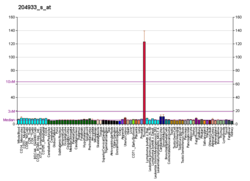Osteoprotegerin (OPG), also known as osteoclastogenesis inhibitory factor (OCIF) or tumour necrosis factor receptor superfamily member 11B (TNFRSF11B), is a cytokine receptor of the tumour necrosis factor (TNF) receptor superfamily encoded by the TNFRSF11B gene.
OPG was first discovered as a novel secreted TNFR related protein that played a role in the regulation of bone density and later for its role as a decoy receptor for receptor activator of nuclear factor kappa-B ligand (RANKL).[5] OPG also binds to TNF-related apoptosis-inducing ligand (TRAIL) and inhibits TRAIL induced apoptosis of specific cells, including tumour cells.[6] Other OPG ligands include syndecan-1, glycosaminoglycans, von Willebrand factor, and factor VIII-von Willebrand factor complex.[7]
OPG has been identified as having a role in tumour growth and metastasis,[6] heart disease,[8][9][10] immune system development and signalling,[7] mental health,[11] diabetes,[12] and the prevention of pre-eclampsia[13] and osteoporosis during pregnancy.[14]
- ^ a b c GRCh38: Ensembl release 89: ENSG00000164761 – Ensembl, May 2017
- ^ a b c GRCm38: Ensembl release 89: ENSMUSG00000063727 – Ensembl, May 2017
- ^ "Human PubMed Reference:". National Center for Biotechnology Information, U.S. National Library of Medicine.
- ^ "Mouse PubMed Reference:". National Center for Biotechnology Information, U.S. National Library of Medicine.
- ^ Simonet WS, Lacey DL, Dunstan CR, Kelley M, Chang MS, Lüthy R, Nguyen HQ, Wooden S, Bennett L, Boone T, Shimamoto G, DeRose M, Elliott R, Colombero A, Tan HL, Trail G, Sullivan J, Davy E, Bucay N, Renshaw-Gegg L, Hughes TM, Hill D, Pattison W, Campbell P, Sander S, Van G, Tarpley J, Derby P, Lee R, Boyle WJ (April 1997). "Osteoprotegerin: a novel secreted protein involved in the regulation of bone density". Cell. 89 (2): 309–19. doi:10.1016/s1525-0016(16)39531-4. PMID 9108485.
- ^ a b Reid PE, Brown NJ, Holen I (July 2009). "Breast cancer cells stimulate osteoprotegerin (OPG) production by endothelial cells through direct cell contact". Molecular Cancer. 8 (1): 49. doi:10.1186/1476-4598-8-49. PMC 2719583. PMID 19604388.
- ^ a b Baud'huin M, Duplomb L, Teletchea S, Lamoureux F, Ruiz-Velasco C, Maillasson M, Redini F, Heymann MF, Heymann D (October 2013). "Osteoprotegerin: multiple partners for multiple functions" (PDF). Cytokine & Growth Factor Reviews. 24 (5): 401–9. doi:10.1016/j.cytogfr.2013.06.001. PMID 23827649.
- ^ Xi L, Cao H, Chen Y (2013). "OPG/RANK/RANKL axis in atrial fibrillation". Cardiology. 125 (3): 174–5. doi:10.1159/000351441. PMID 23752030. S2CID 38746150.
- ^ Hosbond SE, Poulsen TS, Diederichsen AC, Nybo M, Rasmussen LM, Mickley H (August 2012). "Osteoprotegerin as a marker of atherosclerosis: a systematic update". Scandinavian Cardiovascular Journal. 46 (4): 203–11. doi:10.3109/14017431.2012.685491. PMID 22506827. S2CID 22574694.
- ^ Bernardi S, Bossi F, Toffoli B, Fabris B (2016). "Roles and Clinical Applications of OPG and TRAIL as Biomarkers in Cardiovascular Disease". BioMed Research International. 2016: 1752854. doi:10.1155/2016/1752854. PMC 4856888. PMID 27200369.
- ^ Hope S, Melle I, Aukrust P, Agartz I, Lorentzen S, Steen NE, Djurovic S, Ueland T, Andreassen OA (September 2010). "Osteoprotegerin levels in patients with severe mental disorders". Journal of Psychiatry & Neuroscience. 35 (5): 304–10. doi:10.1503/jpn.090088. PMC 2928283. PMID 20569643.
- ^ Nabipour I, Kalantarhormozi M, Larijani B, Assadi M, Sanjdideh Z (May 2010). "Osteoprotegerin in relation to type 2 diabetes mellitus and the metabolic syndrome in postmenopausal women". Metabolism. 59 (5): 742–7. doi:10.1016/j.metabol.2009.09.019. PMID 19922962.
- ^ Shen P, Gong Y, Wang T, Chen Y, Jia J, Ni S, Zhou B, Song Y, Zhang L, Zhou R (2012). "Expression of osteoprotegerin in placenta and its association with preeclampsia". PLOS ONE. 7 (8): e44340. Bibcode:2012PLoSO...744340S. doi:10.1371/journal.pone.0044340. PMC 3431377. PMID 22952959.
- ^ Yano K, Shibata O, Mizuno A, Kobayashi F, Higashio K, Morinaga T, Tsuda E (October 2001). "Immunological study on circulating murine osteoprotegerin/osteoclastogenesis inhibitory factor (OPG/OCIF): possible role of OPG/OCIF in the prevention of osteoporosis in pregnancy". Biochemical and Biophysical Research Communications. 288 (1): 217–24. doi:10.1006/bbrc.2001.5745. PMID 11594776.





